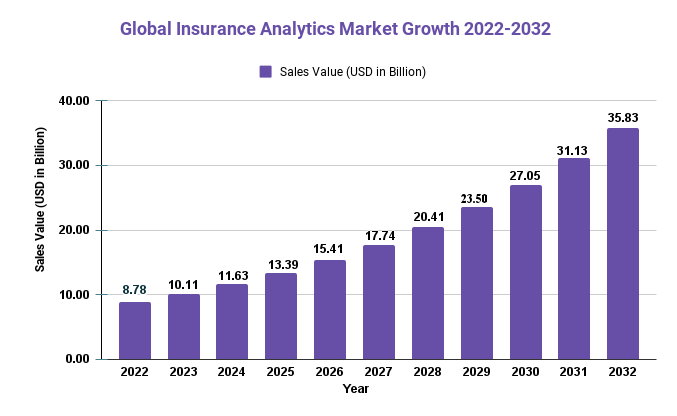Insurance Analytics Market is forecasted to reach USD 35.83 billion by 2032

Page Contents
Market Overview
Published Via 11Press: According to Market.us' report, the global insurance analytics market size was valued at USD 8.78 billion in 2022 and is forecasted to reach USD 35.83 billion by 2032, growing at a compound annual growth rate (CAGR) of 15.1% from 2022-2032.
The market growth can be attributed to the increasing adoption of advanced technologies like artificial intelligence (AI), machine learning (ML), and big data analytics by insurance companies to enhance operational efficiency, optimize pricing strategies, and enhance customer experience. Insurance analytics solutions give insurers valuable insights into customer behavior, risk management, fraud detection, and claims processing among other areas.
The report highlights the growing demand for cloud-based insurance analytics solutions due to their scalability, flexibility, and cost efficiency. Furthermore, Asia Pacific is expected to experience significant growth in this market due to the increasing adoption of digital technologies and an expanding insurance industry within the region.
Overall, the insurance analytics market is forecast to maintain its growth trajectory in the coming years due to the increasing adoption of advanced analytics technologies by insurance companies to gain a competitive edge and enhance their business operations.
Request For Sample Report Here: https://market.us/report/insurance-analytics-market/request-sample

Regional Snapshot
- North America: North America is the leading market for insurance analytics due to the widespread adoption of digital technologies and the presence of major insurers there. The US and Canada have been particularly influential in driving market growth within this region.
- Europe: Europe is the second-largest market for insurance analytics, driven by an increasing focus on customer centricity, regulatory compliance, and fraud detection by insurers. The UK, Germany, and France are major contributors to this region's growth in this space.
- Asia Pacific: The Asia Pacific market is projected to experience significant growth over the coming years due to the increasing adoption of digital technologies and an expanding insurance industry in this region. China, India, and Japan are major contributors to market development within this region.
- Middle East and Africa: The Middle East and Africa insurance analytics market is expected to experience strong growth, driven by the increasing adoption of digital technologies as well as an increasing need for risk management and fraud detection in this region.
- Latin America: The Latin American market for insurance analytics is forecast to expand due to the increasing adoption of digital technologies and expanding insurance industry in this region. Brazil and Mexico are leading contributors to market development within this region.
Market Dynamics
Drivers
- Competition: The insurance industry is becoming more and more competitive, with new players entering the market and existing players expanding their product offerings. Insurance analytics solutions give insurers insights into customer behavior and preferences, help optimize pricing strategies, and enhance the customer experience – giving them a strategic advantage in this battle.
- Growing Need for Risk Management: Insurance companies face various risks, such as financial, operational, and reputational. Insurance analytics solutions help insurers assess and manage these hazards more effectively, decreasing the chance of losses while improving profitability.
- Technological Advancements: Advancements such as artificial intelligence (AI), machine learning (ML), and big data analytics are revolutionizing the insurance industry, giving insurers insights into customer behavior, detecting fraud, and optimizing business operations.
- Enhancing Customer Expectations: Customers expect personalized and seamless experiences from insurers, which can be achieved with the aid of insurance analytics solutions. These programs give insurers insights into customer behavior and preferences so that they can provide tailored products and services accordingly.
- Regulatory Compliance: Insurance companies must abide by stringent regulations such as GDPR and CCPA that require them to protect customer data and uphold data privacy. Insurance analytics solutions help insurers meet these obligations by offering secure and compliant data management solutions.
Restraints
- Lack of Skilled Workforce: Successful implementation of insurance analytics solutions necessitates a skilled workforce with expertise in data analytics, AI, and ML. Unfortunately, there is an acute shortage of professionals within this industry which is hindering its adoption.
- Data Quality and Management: Insurance companies generate and store vast amounts of data, but its quality can often be questionable. This makes it difficult to gain meaningful insights. Furthermore, managing and storing this information can be expensive and time-consuming.
- Integration Challenges: Integrating insurance analytics solutions with existing legacy systems can be a time-consuming endeavor that requires significant resources. This may pose an impediment to the adoption of these solutions, especially among smaller insurance companies.
- Data Privacy and Security Concerns: The insurance industry is subject to various regulations that require insurers to protect customer data and uphold data privacy. Implementing insurance analytics solutions must meet these standards, which can be complex and expensive.
- Cost: Implementing insurance analytics solutions can be expensive, particularly for smaller insurance companies with tight budgets. Furthermore, ongoing maintenance and support expenses could become a deterrent to adoption.
Opportunities
- Personalization: Insurance analytics solutions give insurers valuable insights into customer behavior and preferences, enabling them to provide personalized products and services. This leads to improved customer satisfaction and loyalty – ultimately increasing revenues.
- Fraud Detection: Insurance fraud is a major issue in the industry, costing insurers billions of dollars annually. Insurance analytics solutions can help detect fraudulent claims, helping reduce losses and boost profitability.
- Telematics: Telematics technology, which utilizes sensors and GPS tracking to monitor driver behavior, is becoming more widely adopted in the auto insurance industry. Insurance analytics solutions can help insurers analyze telematics data to gain insights into driver behavior and risk so they can provide more precise pricing and risk management strategies.
- Predictive Analytics: Insurance analytics solutions can assist insurers in accurately forecasting customer behavior and risk, enabling them to provide more precise pricing and risk management strategies. This leads to improved profitability as well as reduced losses.
- New Product Offerings: Insurance analytics solutions can enable insurers to identify new product offerings that are tailored to customer needs and preferences, potentially leading to increased revenues and market share.
View Detailed TOC of the Report | https://market.us/report/insurance-analytics-market/table-of-content/
Challenges
- Data Quality and Management: Insurance companies generate and store vast amounts of data, but its quality can often be poor, making it difficult to gain meaningful insights. Furthermore, managing and storing this information can be expensive and time-consuming.
- Integration Challenges: Integrating insurance analytics solutions with existing legacy systems can be a difficult undertaking, necessitating considerable time and resources. This may pose an impediment to the adoption of these solutions, particularly by smaller insurers.
- Lack of Skilled Workforce: Successful implementation of insurance analytics solutions necessitates a skilled workforce with expertise in data analytics, AI, and ML. Unfortunately, there is an acute shortage of professionals within this industry which is hindering its adoption.
- Data Privacy and Security Concerns: The insurance industry is bound by various regulations that require insurers to protect customer data and guarantee data privacy. Implementing insurance analytics solutions must meet these standards, which can be complex and expensive processes.
- Cost: Implementing insurance analytics solutions can be expensive, particularly for smaller insurers with tight budgets. Furthermore, ongoing maintenance and support expenses could prove a deterrent to adoption.
- Lack of Standardization: Lack of standardization in the industry makes it challenging for insurers to share data and insights, potentially impeding the development of industry-wide best practices.
Key Market Segments
Type
- Managed services
- Professional services
Application
- Claim management
- Risk management
- Process optimization
- Customer management and personalization
Key Market Players
- IBM (US)
- Microsoft (US)
- Oracle (US)
- SAP SE (Germany)
- Salesforce (US)
- SAS Institute (US)
- OpenText (Canada)
- Verisk Analytics (US)
- Tableau Software (US)
- Pegasystems (US)
- Hexaware (India)
- Guidewire (US)
- MicroStrategy (US)
- Sapiens International (Israel)
- LexisNexis (US)
- Palantir (US)
- TIBCO Software (US)
- Applied Systems (US)
- Birst (US)
- BOARD International (Switzerland)
Report Scope
| Report Attribute | Details |
| The market size value in 2022 | USD 8.78 Bn |
| Revenue forecast by 2032 | USD 35.83 Bn |
| Growth Rate | CAGR Of 15.1% |
| Regions Covered | North America, Europe, Asia Pacific, Latin America, and Middle East & Africa, and Rest of the World |
| Historical Years | 2017-2022 |
| Base Year | 2022 |
| Estimated Year | 2023 |
| Short-Term Projection Year | 2028 |
| Long-Term Projected Year | 2032 |
Frequently Asked Question
Q: What is the current market size for the Big Data Services Market?
A: According to a report by Market.us, the Big Data Services Market was valued at USD 50.20 billion in 2022 and is expected to reach USD 298.11 billion by 2032, growing at a CAGR of 19.5% during the forecast period.
Q: What are the key segments of the Big Data Services Market?
A: The Big Data Services Market can be segmented based on Type (Managed services, Professional services), By Application (Claim management, Risk management, Process optimization, Customer management, and personalization), and geography (North America, Europe, Asia-Pacific, Latin America, and Middle East & Africa).
Q: Who are the key players in the Big Data Services Market?
A: Some of the key players in the Big Data Services Market include IBM (US), Microsoft (US), Oracle (US), SAP SE (Germany), Salesforce (US), SAS Institute (US), OpenText (Canada), Verisk Analytics (US), Tableau Software (US), Pegasystems (US), Hexaware (India), Guidewire (US), MicroStrategy (US), Sapiens International (Israel), LexisNexis (US), Palantir (US), TIBCO Software (US), Applied Systems (US), Birst (US), BOARD International (Switzerland).
The team behind market.us, marketresearch.biz, market.biz and more. Our purpose is to keep our customers ahead of the game with regard to the markets. They may fluctuate up or down, but we will help you to stay ahead of the curve in these market fluctuations. Our consistent growth and ability to deliver in-depth analyses and market insight has engaged genuine market players. They have faith in us to offer the data and information they require to make balanced and decisive marketing decisions.



